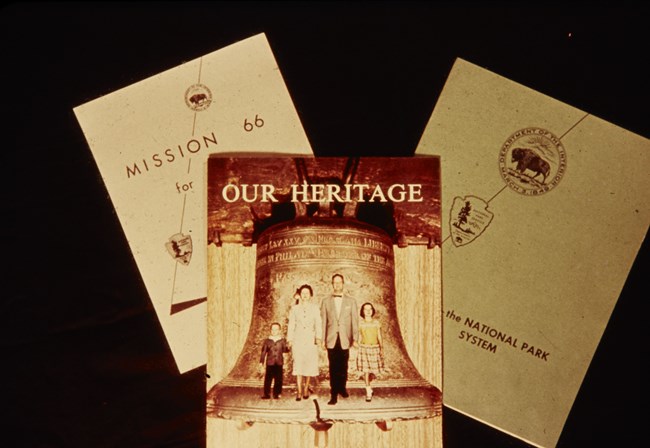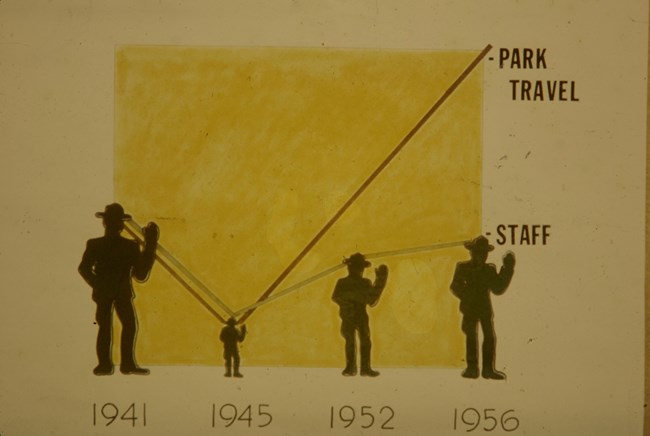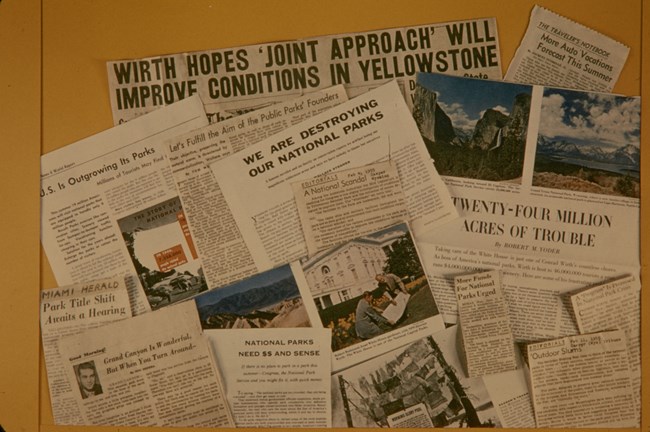Last updated: September 1, 2023
Article
Mission 66 Background and History

In the early 1950s, visitation to national parks was rising rapidly, while conditions in those parks were declining.
Decades of deferred maintenance to buildings, roads, and other infrastructure had led to collapsing safety rails, barely passable roads, and failing water, sewer, and trash systems. During World War II, personnel and budgets decreased by more than half as resources were reallocated for wartime efforts. After the war, budgets remained low as infrastructure continued to deteriorate. In contrast, visitation across the National Park System was surging. In 1945, only 11.7 million people visited the parks. By 1954, visitation had skyrocketed to 47.8 million.
People took notice of deteriorating conditions. Critic Bernard DeVoto wrote a long opinion piece on the state of the parks for Harper’s Magazine, describing it as “nationally disgraceful.” John D. Rockefeller, Jr., a long-time supporter of the parks, called the state of the parks a “national tragedy” in correspondence to President Dwight Eisenhower. National Park Service leadership faced two hard choices: restrict access to parks or pursue a massive overhaul to park infrastructure. Conrad Wirth, the director of the National Park Service from 1951 to 1964, strongly believed that access to the parks was a right for the American people and that parks played a key role for the general public’s wellbeing. He was a strong advocate of modernizing and expanding the park system.
But revitalizing the parks was easier said than done. In previous years, Congress had turned down the National Park Service’s requests for funding to make necessary changes. As the years wore on, the political climate began to shift as the nation entered a period of economic property. Additionally, public awareness of the need for revitalization in the parks began to gain momentum.
Sensing the opportunity, Wirth gathered committees of National Park Service staff to draft an ambitious, far-reaching plan. He believed a comprehensive, long-term program was most appropriate. The result was a bold proposal of about $1 billion spanning 10 years known as Mission 66. Mimicking wartime practices, Wirth and his colleagues drafted plans for Mission 66 with secrecy and a sense of urgency. Even the name, “Mission 66,” intentionally echoed a war-like tone. The name was also chosen because the program would conclude in 1966 to commemorate the 50-year anniversary of the National Park Service.
Wirth presented the Mission 66 program for the first time to National Park Service officials at the Public Services Conference at Great Smoky Mountains National Park in September 1955. In the months that followed, he showcased it to officials across the federal government, including President Eisenhower.
Wirth’s tireless campaign, along with the growing recognition of the parks’ crisis, reached a tipping point: Congress approved funds for the project. Mission 66 was officially underway in 1956.

Post-War Influences in the Parks
After the end of World War II, the United States entered an era of economic prosperity marked by fundamental shifts in daily life for American families. Families found themselves with more access to leisure time. Automotive sales and vehicle travel soared to new heights. Families began to spread into newly built suburbs, migrating away from urban centers.
The rising trend of private vehicle ownership was accompanied by widespread development of car-friendly infrastructure. The same year Mission 66 began, President Eisenhower signed the Federal-Aid Highway Act of 1956, funding the construction of the interstate highway system. Across the United States, private motor vehicle travel was becoming the new way of life.
This cultural shift made its way into the National Park Service, too. Updating vehicle infrastructure was a major priority of Mission 66. Historically, roads in many parks were built for horse-drawn vehicles and often unpaved. Rapidly increasing numbers of private motor vehicles entering the parks highlighted how the old roads were deteriorating and inadequate.
Promotional materials for Mission 66 emphasized the romanticism of family road trip vacations. The National Park Service even forged partnerships with several private companies in the automotive industry. For instance, Phillips Petroleum sponsored some Mission 66 materials and Sinclair Oil ran a print advertisement praising the Mission 66 project. Meanwhile, as National Park Service officials courted private automotive companies, it did not seek input from conservation groups like the Sierra Club and Wilderness Society during initial planning of Mission 66. The new partnerships the National Park Service was cultivating with automotive groups sparked concerns among conservationists that park management was placing too much emphasis on development.
The frustration that conservationists felt during the early days of Mission 66 foreshadowed clashes between the National Park Service and conservationists that would arise just a few years later.

The Legacy of Mission 66
The monumental efforts of Mission 66 equipped the National Park Service with infrastructure that has served millions of visitors for decades. The wave of construction ushered in a new era of park architecture known as Park Service Modern. Some of the Modern buildings constructed during Mission 66 are now National Historic Landmarks. The legacy of Mission 66 is more than a list of buildings and infrastructure projects: it was a pivotal era in the history of the National Park Service.
While the program was underway, Mission 66 was met with a mix of positive reception and criticism. During the years that Mission 66 was at its height, the environmental movement was gaining momentum. Conservationists criticized Mission 66 for placing too much emphasis on development. These concerns, combined with other issues of the day, spurred the creation and passage of the Wilderness Act of 1964, one of the most important pieces of public lands legislation.
Similarly, conservationists voiced concerns that the National Park Service was not doing enough to expand its in-house scientific research programs. While Mission 66 expanded the development footprint of the parks, scientific research programs did not receive the same revitalization as other areas of park management. For instance, in 1958, the National Park Service employed only two wildlife biologists in research and policy. Critics believed that the National Park Service needed more scientific perspective to ensure development efforts like Mission 66 would not ecologically compromise natural resources in the parks.
As the National Park Service’s approach to natural resource management fell under increasing scrutiny, in part as a direct result of Mission 66, this era was ultimately the moment that leadership recognized the need for change. After Mission 66, the role of scientific research in park management would continue to grow and evolve for multiple decades. Today, natural resource management in the National Park Service includes both robust research programs and traditional knowledge. While contentious at the time, these controversies were the growing pains that ultimately gave way to significant progress for conservation and management of public lands.
To varying degrees, many of the problems that spurred Mission 66 still afflict our parks today. The National Park Service still must weigh challenging tradeoffs that manage visitation and provide access without significantly harming the natural and cultural resources the parks are meant to protect.
At its core, Mission 66 highlights the tension between conservation and use. With more than 100 years of history, the resource management ethos of the National Park Service has evolved continuously. Mission 66 marks the tipping point between an old management strategy that considered relatively few factors, to a new kind of management with a stronger conservation lens.
We can learn a lot from both the successes and shortcomings of Mission 66. Through this unique moment in National Park Service, we can better answer what it means to leave our parks unimpaired for the enjoyment of future generations.
